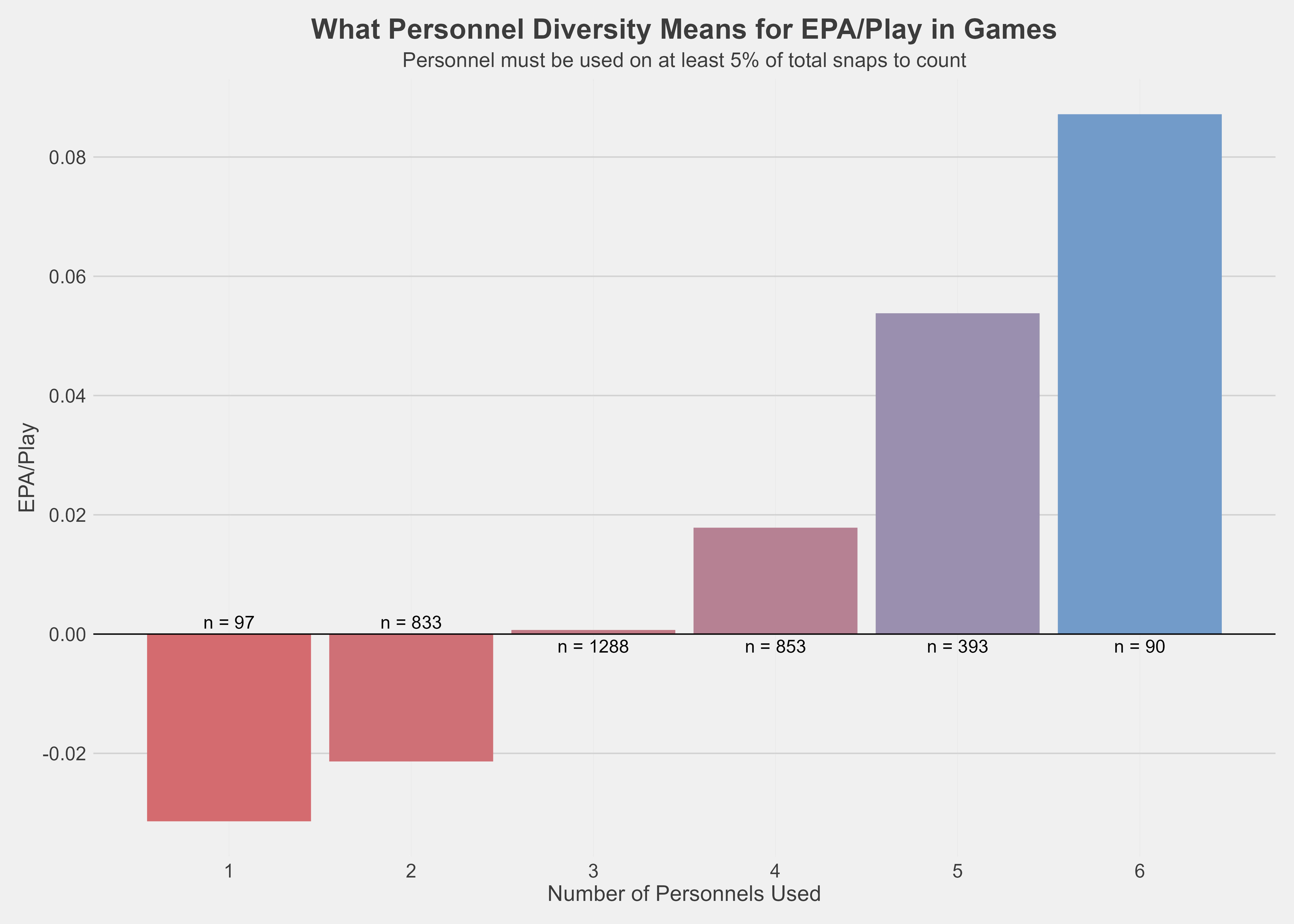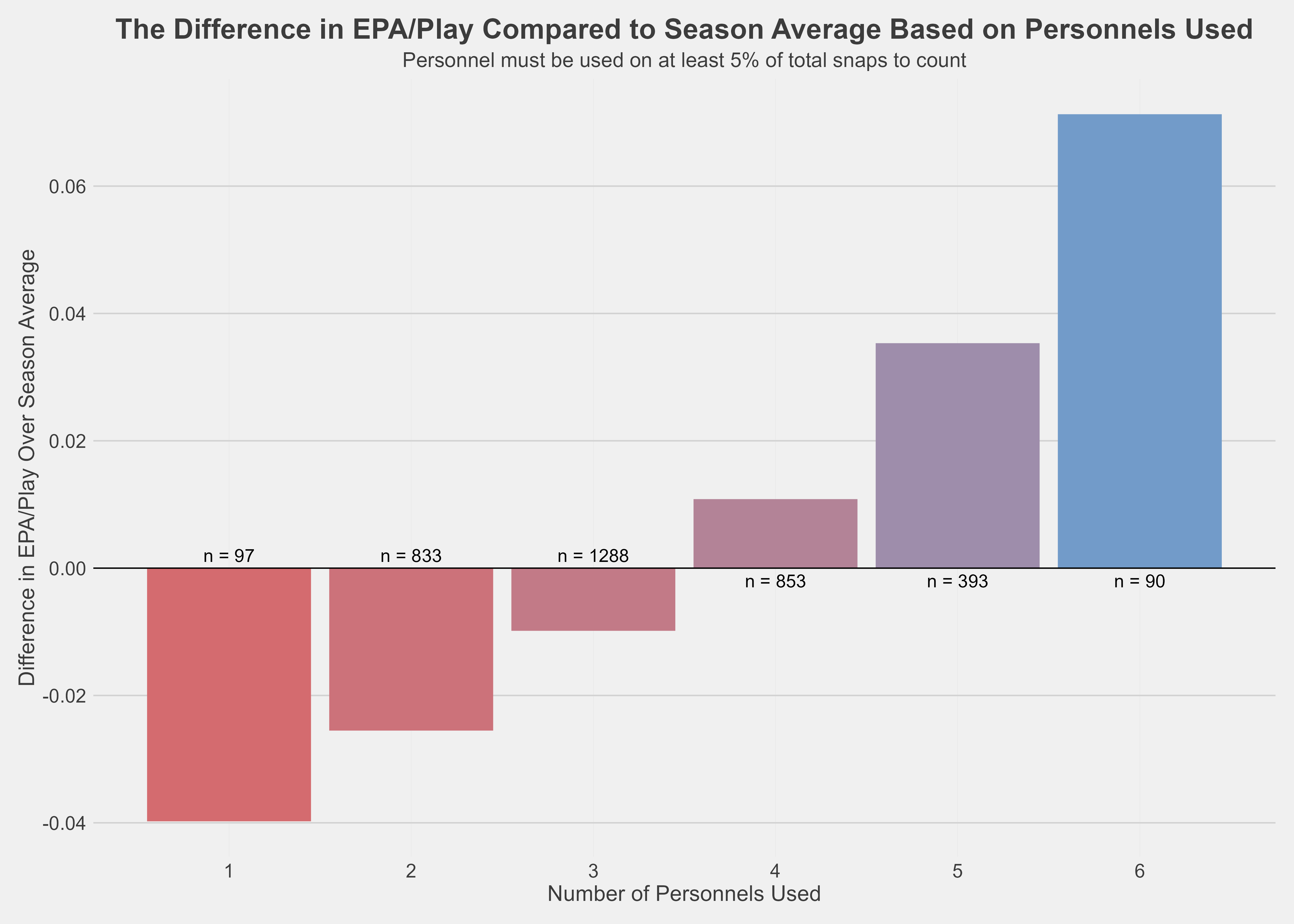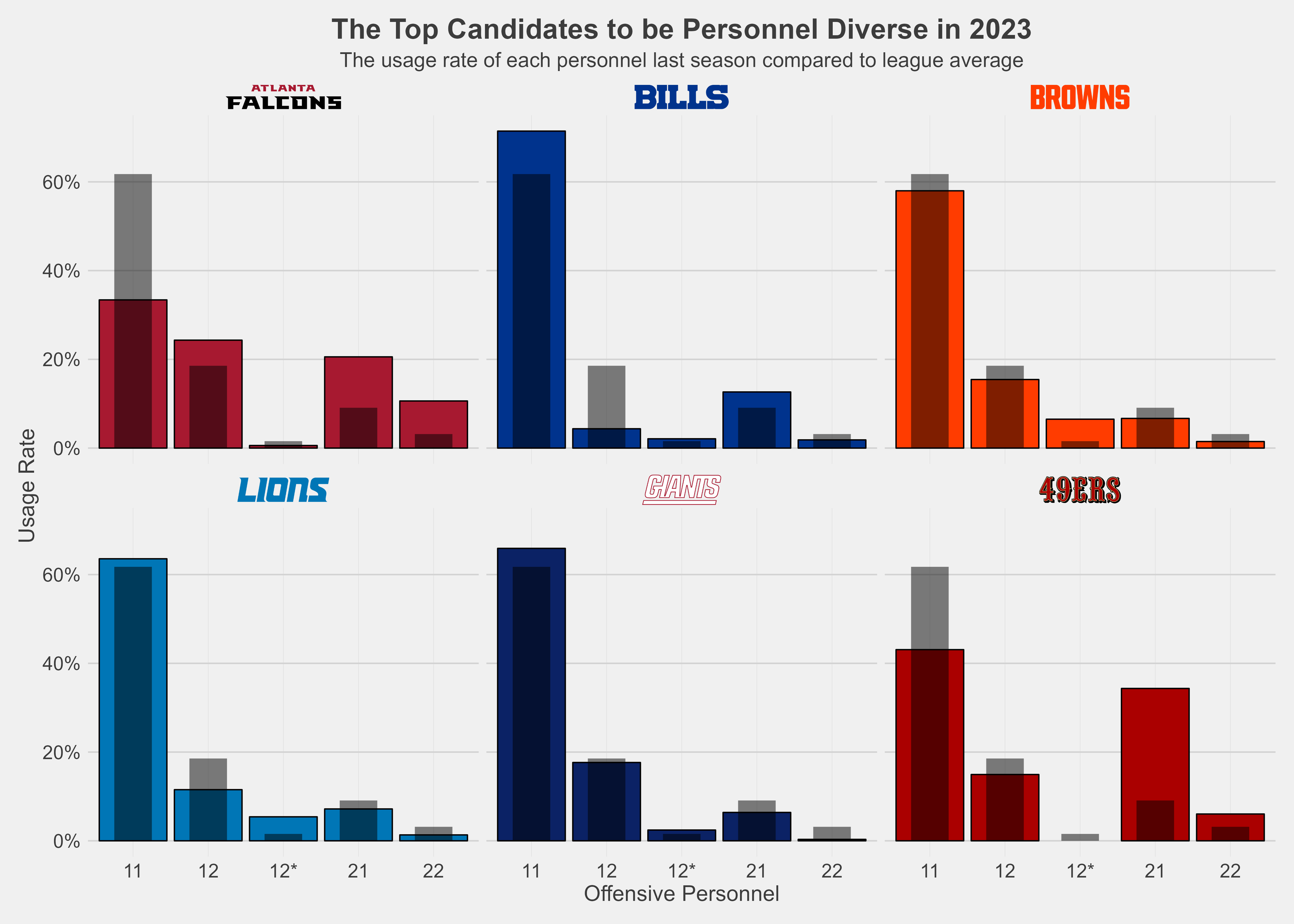In football, being truly versatile has been the calling card of many great defenses; it is often associated with Bill Belichick’s Patriots. The ability to use hybrid players to play multiple roles gives the defense the tools to match the offense regardless of the situation. We have yet to see a modern offense reach this level of positionless play.
In 2022, the San Francisco 49ers came the closest with a running back in Christian McCaffrey that could play receiver, a wide receiver in Deebo Samuel that could play running back, a tight end in George Kittle that could block and catch at a high level, and a fullback in Kyle Juszczyk that could play anywhere. The 49ers were one of six teams last season to use at least 4 different personnels on at least 5% of their snaps. They were able to do this in a large part due to their unique players, but also because Kyle Shanahan understands how to take advantage of the talents in the offensive meeting room.

Personnel describes what combination of positions the offense has on the field at a given time. The NFL’s most common personnel group is 1 running back and 1 tight end, which is called 11 personnel. The second most common is 12 personnel (1 running back and 2 tight ends). When the offense puts an extra offensive lineman on the field, it gets labeled with a star for data purposes. This means 21* is 2 running backs, 1 tight end and a 6th offensive lineman (with one less receiver).
From this figure alone, we see a slight trend between the number of different personnels a team uses at least 5% of the time and how well their offense performs. Although you need a certain type of roster construction and coaching staff to execute this, we can see teams like the Ravens and Browns both be diverse in personnel usage. Despite playing with backup quarterbacks for large parts of the year, these teams finished with a positive EPA/play. On the other side, only one team last year was able to use 2 main personnels and finish with a top 10 offense – the Buffalo Bills.
Simply adding more personnel groupings is not adequate for offensive success. Each team must have a coherent offensive plan along with players that are able to be more flexible than their position suggests. If a player is given a position title but only plays like another position (a player that is called a tight end but truly only plays receiver) much of the value of diversity is lost as the defense decides how to treat each player. Play callers also must understand how to leverage personnel diversity through a combination of formations and motions to put players into positive situations.
Personnel Diversity in Games
When looking at it from the game level, the impact of being personnel diverse becomes more evident.

Since 2016, it has been rare that a team uses 1 or 6 personnels in a game. Thus, we can focus on the 2-5 range here. Each personnel added to an offense increased their EPA/play in the game at a linear rate. Offenses that used only 2 personnels in a game often experience a negative EPA/play while 3 personnels hovered around neutral with 4 and 5 personnels seeing a big increase in positive efficiency.
This might be a chicken or the egg problem where better offenses are more naturally able to achieve more personnel diversity. However, when looking at the difference in EPA/play from the offense’s season average, we can see that this is not the case.

Offenses that use 3 personnels in a game have a lower EPA/play, on average, than their season average, but those that use 4 or 5 personnels in a game see an increase over their offense’s baseline output. Some of the best play callers in the league are leaning into this concept with Kyle Shanahan having 9 games last season using 4 or 5 personnels in a game (4th most) plus Ben Johnson having 8 games (6th most). Despite middling results last season, fans of the Browns and Falcons should be optimistic about their offenses due to their play callers taking advantage of multiple personnel groupings.
Personnel Diversity in 2023
Based on last year’s personnel diversity plus offseason moves, there are some main candidates to lean into throwing out 4 or 5 personnels in games this season.

Atlanta Falcons: In 2022, Arthur Smith had the Falcons cycle between 11, 12, 21, 22, and 13 personnel on at least 5% of snaps with none of those getting above 35% in total usage. In the offseason, the Falcons used the #8 pick on running back Bijan Robinson and traded for Jonnu Smith. This gives the Falcons 3 running backs and 2 tight ends that are all capable of registering playing time.
We will likely see all the common personnels we saw last season but also can expect Arthur Smith to lean into the flexibility of his roster using Pitts, Robinson, and Patterson all lined up in different spots. Smith has a deep knowledge of the run game and may be able to help out his quarterback through the air this year.
Falcons running pistol wide zone lead vs. Pittsburgh plugging into a 6-1 front pic.twitter.com/tvz3G343wd
— Shawn Syed (@SyedSchemes) July 25, 2023
San Francisco 49ers: As mentioned earlier, due to a combination of the 49ers’ roster and Kyle Shanahan’s emphasis on versatility, they will likely be personnel diverse again in 2023. After trading for Christian McCaffrey, the 49ers used 11 and 21 personnel at roughly the same rate while also mixing in 12 and 22 personnel. With a full offseason to design an offense with McCaffrey, we could see a lot more 21 and 22 personnel as well as some 31 personnel with McCaffrey lined up out wide and both Kyle Juszczyk and another running back in the backfield.
On Christian McCaffrey's big run, SF went to a variation of a play they ran earlier in the year. Kyle Juszczyk with a nice crack on the ILB, Kittle is protecting Williams' inside hip (like they would for a TE on Zorro) up to the CB and WR is push cracking the Safety https://t.co/wmhmMictz8 pic.twitter.com/YhB70IiTjm
— Shawn Syed (@SyedSchemes) January 14, 2023
Cleveland Browns: The Browns were another team that rotated between 11, 12, 21, 12*, and 13 personnel last season using 11 on 58% of snaps but diversifying with the others. The Browns’ trade for wide receiver Elijah Moore may increase their usage of 11 personnel, but it is clear that they understand personnel diversity can be positive.
A plausible way for the Browns to repeat this trend is to use fourth-round pick Dawand Jones as an extra offensive lineman. This would allow them to get into 11* personnel and 12* personnel and dominate on the ground.
Browns mashing out of 13p pic.twitter.com/UdUoiQdo29
— Shawn Syed (@SyedSchemes) November 7, 2021
Detroit Lions: While the Lions saw a decrease in their personnel diversity after the T.J. Hockenson trade, the draft picks of running back Jahmyr Gibbs and tight end Sam LaPorta could make them one of the more personnel diverse teams in the league this season. Adding both Gibbs and David Montgomery to the backfield should allow Ben Johnson to increase his usage of 21 and 22 personnel.
LaPorta, alongside Brock Wright, is going to allow the Lions to increase their 12 and 12* personnel usage as well. The Lions used an extra offensive lineman at the 5th highest rate last season giving them diversity in multiple aspects, especially in the run game. That should continue to grow in 2023.
Lions with a nice Hiccup variation from 21phttps://t.co/8LajjsgxYZ pic.twitter.com/374wZ9qio7
— Shawn Syed (@SyedSchemes) January 9, 2023
New York Giants: The Giants were not as personnel diverse last season as some of the teams already mentioned, using primarily 11 personnel and mixing in some 12 and 21 personnel. However, their big splash of the offseason was trading for Darren Waller to give them two tight ends that are likely to see the field in Waller and Daniel Bellinger. The added tight end gives them the flexibility to get into 12 and possibly 13 personnel more often than last year.
Safety steps down into the box to fill, Jones hits the glance behind him pic.twitter.com/qKMLOEawg0
— Shawn Syed (@SyedSchemes) August 2, 2023
Buffalo Bills: The Bills were one of the least personnel diverse teams last season, living in 11 personnel, and were still able to be efficient because of Josh Allen and Stefon Diggs. Despite that, it was clear by the end of the season that a lot of strain was put on the Allen-Diggs connection. This offseason, the Bills used their first-round pick on tight end Dalton Kincaid and made an under the radar signing with Damien Harris to back up James Cook.
While it requires a bit of projection, we could see the Bills lean into 12 personnel a lot more this season and some 21 personnel and 22 personnel in the redzone. While Kincaid might not necessarily be treated as a traditional tight end from the defensive perspective, he may add another dimension to the Bills offense if he is able to be versatile.
What it All Means
From looking at the data at a season level and game level, it is noticeable that the more personnels a team is able to use, the more efficient their offense should be. Defensive coordinators may feel more comfortable facing teams that use less diverse personnel as they can match personnel by situation more easily.
As John Taormina, former Director of Analytics for the Atlanta Falcons laid it out, “If defenses prepare for an offense by primarily studying each personnel group separately, the more groups an offense utilizes that a defense prepares for, the quality of preparation will naturally decrease as time is a constraint.”
Even just using unique personnels at a 5% rate is adequate to make an offense diverse enough to force defenses to prepare for a more varied menu. The 11 personnel boom, led by Sean McVay among others, still leads the way in the NFL. Yet, the unique athletes in the league may allow teams to reach a personnel diversity previously unseen.
